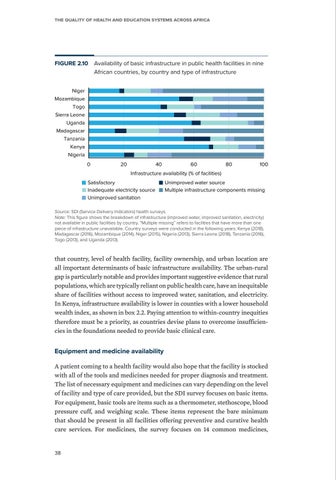The Quality of Health and Education Systems Across Africa
FIGURE 2.10 Availability of basic infrastructure in public health facilities in nine African countries, by country and type of infrastructure Niger Mozambique Togo Sierra Leone Uganda Madagascar Tanzania Kenya Nigeria 0
20
40
60
80
100
Infrastructure availability (% of facilities) Satisfactory Inadequate electricity source Unimproved sanitation
Unimproved water source Multiple infrastructure components missing
Source: SDI (Service Delivery Indicators) health surveys. Note: This figure shows the breakdown of infrastructure (improved water, improved sanitation, electricity) not available in public facilities by country. “Multiple missing” refers to facilities that have more than one piece of infrastructure unavailable. Country surveys were conducted in the following years: Kenya (2018), Madagascar (2016), Mozambique (2014), Niger (2015), Nigeria (2013), Sierra Leone (2018), Tanzania (2016), Togo (2013), and Uganda (2013).
that country, level of health facility, facility ownership, and urban location are all important determinants of basic infrastructure availability. The urban-rural gap is particularly notable and provides important suggestive evidence that rural populations, which are typically reliant on public health care, have an inequitable share of facilities without access to improved water, sanitation, and electricity. In Kenya, infrastructure availability is lower in counties with a lower household wealth index, as shown in box 2.2. Paying attention to within-country inequities therefore must be a priority, as countries devise plans to overcome insufficiencies in the foundations needed to provide basic clinical care.
Equipment and medicine availability A patient coming to a health facility would also hope that the facility is stocked with all of the tools and medicines needed for proper diagnosis and treatment. The list of necessary equipment and medicines can vary depending on the level of facility and type of care provided, but the SDI survey focuses on basic items. For equipment, basic tools are items such as a thermometer, stethoscope, blood pressure cuff, and weighing scale. These items represent the bare minimum that should be present in all facilities offering preventive and curative health care services. For medicines, the survey focuses on 14 common medicines,
38


